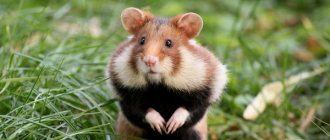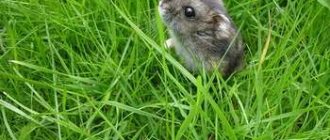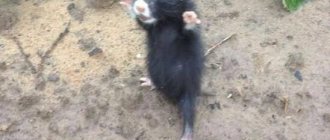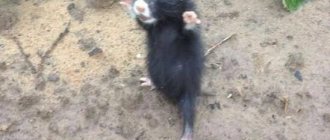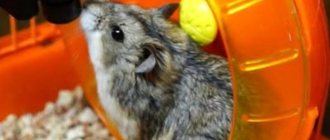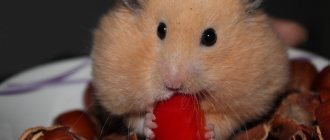The closest relatives of domestic rodents have noticeable differences in lifestyle and physical development, since life in the wild requires skill and independence. The steppe hamster has a large body size, small ears, and well-developed limbs. Wild rodents have especially developed fingers, which serve them to create a home - digging large holes in the ground.
Steppe rodents are absolutely unique and do not need human help in order to survive. On the contrary, such hamsters can show aggression in response to attention from people, so when meeting a steppe inhabitant, do not try to communicate or obsessively feed the animal.
Structure and appearance
Steppe hamsters visually resemble their decorative counterparts, but are larger in size. Adult males grow to 37-39 cm in length and weigh about 650-700 g.
Brief description of wild hamsters:
- The muzzle is moderately elongated, with neat cheek pouches, stiff whiskers and shiny black beady eyes.
- The ears are small, rounded, covered with dark hairs.
- The teeth are sharp and long. They grow throughout life and need systematic grinding.
- The body is stocky, dense, with an almost invisible neck and a thick tail with a tapered tip.
- The limbs are short, strong, with developed feet and strong claws on long toes.
- The fur is dense, soft, with a pronounced down. Coat color may vary. Most often among steppe hamsters there are individuals with red-brown or yellow fur. The abdomen of wild animals is usually painted charcoal, and there are light markings behind the ears, in the area of the shoulder blades, on the sides of the head and body. Occasionally in nature there is a steppe black hamster with snow-white spots on its paws and throat.
Description of the species
The common steppe, or field, hamster is nocturnal and is the largest representative of this family. He spends his days mostly in the hole, and at night he goes out to fish.
These animals are solitary animals and live in pairs only during the breeding season. They are pugnacious, can show aggression towards each other, and are not afraid to attack an opponent much larger than themselves, even a person. Before the attack, the fluffy stands on its hind legs and attacks with a swift jump. Their natural enemies are predators such as ferrets and foxes.
We recommend reading what breed of hamster to choose and how to care for a Syrian and Djungarian hamster
In the description, the common hamster appears to us as a cute, fluffy animal with a brightly colored skin. It has thick soft fur of a red or grayish-brown color; the belly and the area between the ears are black; The cheeks, cheek pouches, and tips of the paws are white, and white stripes also decorate the sides. Paws with well-developed toes and sharp claws on the inside are pink. The tail is up to 8 cm, covered with short, stiff hair. Body length up to 34 cm, weight up to 800 grams.
Those who want to have such a pet are interested in the question: do hamsters hibernate? In nature, they spend the winter in burrows, but they do not sleep soundly: they wake up about once a week to eat and relieve their natural needs.
Also, at home you can keep such rodents as: jerboa, Chilean squirrel, chipmunk, squirrel, capybara, guinea pig, dormouse
Duration and lifestyle
In their natural environment, wild hamsters live no longer than 4 years. Steppe rodents lead a solitary lifestyle and jealously guard their possessions. The peak activity of karbysh occurs at night. During the day, steppe animals sit in burrows.
Field hamsters are not afraid of low temperatures and harsh climates. With the onset of cold weather, wild rodents hibernate. Karbysh hibernate in a shallow earthen burrow and sometimes awaken to feed.
The steppe and forest hamster gets to the surface only after the snow has completely melted. The males are the first to leave their homes, and a little later the females follow their example.
For burrows, steppe and forest hamsters adapt ready-made tunnels that were dug by gophers and other animals. Rodents usually seek out and modernize abandoned homes. But if necessary, the karbysh easily kick out the owners.
The burrows of steppe hamsters are arranged in a very interesting way. They consist of several rooms and nests, which are lined with dry grass. The depth of hamster dwellings can reach 1.5 m, and the width - up to 8 m. Each burrow has about a dozen exits, some of which are false.
On a note. The forest hamster is very aggressive. Moreover, the hostility of a wild rodent even extends to humans. The bites of the steppe hamster are very painful, but he never attacks first.
Hibernation
A wild hamster is susceptible to hibernation, since it has no other option other than a slow metabolism to endure harsh weather conditions. He begins to wake up when the earth freezes. This usually happens in February, sometimes a little later.
A notable feature is that the hamster will not immediately open its entrances and exits. First, he will sit in the hole for some time, eating up the remaining supplies, and only after a month the holes will be open.
Females come out later, closer to mating time.
First, after hibernation, animals begin to eat seeds and grains that they find in the fields. Then they proceed to the young shoots. But at any time after hibernation, hamsters are ready to feast on meat. They will not hunt on their own; their diet will be varied only if they encounter a weak or wounded animal along the way.
Habitat
The wild hamster is distributed almost everywhere. The habitat of the carbysh covers the Caucasus, Siberia, Altai and the Crimean Peninsula. The hamster is found in Kazakhstan, China and many European countries.
Previously, the animal lived in the steppe, forest-steppe and mixed-grass meadows. But due to large-scale deforestation, the rodent's distribution area has expanded significantly. The wild hamster successfully colonizes gardens, fields, orchards and summer cottages. And if there is a lack of food, the animal can settle in living quarters.
On a note. A wild hamster alone is capable of destroying the lion's share of the crop. Therefore, in dachas you need to pay attention to signs of the presence of a pest. The steppe rodent leaves characteristic marks, digs at the roots of carrots and potatoes, and also eats the bark at the very bottom of trees.
Harm to a person - a farmer
Karbysh often settle near fields, dachas, and farms. With large populations, they are capable of causing great damage to crops. Everything that a rodent finds in the field is edible for it.
It is easy to detect the presence of a rodent: you can see teeth marks on fruits and vegetables, bark has been eaten at the bottom of trees and bushes. Traces of digging are visible on plantings of potatoes, carrots and other root crops.
Hamsters reproduce exponentially. If no measures are taken, they will fill all the fields with their holes.
Hamsters bring not only harm, but also benefit, destroying beetle larvae in the fields, eating insect pests, including locusts, which cause enormous damage to farmers.
Interesting Facts
The steppe hamster is a rather entertaining rodent. Not surprisingly, there are a lot of interesting things associated with it:
- These rodents are considered carriers of about 30 dangerous infectious diseases. And at the sites of their bites, lacerations often remain.
- Until the mid-1940s, the wild hamster was considered a fur-bearing animal. The fur of the steppe rodent was widely used in the clothing industry. True, to make 1 fur coat, 200-250 skins are required.
- The animal has several alternative names. It is often called “karbysh”, “common hamster”, “forest”, “garden” or “garden” hamster.
Character
The hamster is the most aggressive and evil rodent. If other species of its family prefer not to appear in front of humans, then this one will rush into battle at the first opportunity. Moreover, these animals rush at dogs that are several times larger than themselves.
Even if you look at what a hamster eats, you can immediately recognize its evil character. For example, if a male meets a female not during mating, he will bite her to death. If, during the mating process itself, several contenders line up for the process, then the weaker ones rarely manage to survive.
It is impossible not to note the love of animals for territorial division. Males can control land up to 12 hectares, females - a little less. If another animal enters the territory of one hamster, a fight ensues. Moreover, the owner of the land will defend himself as zealously as possible.
Thus, a meeting with a steppe hamster does not bode well. The only way to make a good pet out of him is to bring a very small individual into the house, which will not know how its relatives live.
Nutritional Features
The field hamster is omnivorous. Although the rodent's usual diet consists of vegetation, in the spring and summer the carbysh eats mollusks, crustaceans, small reptiles and insect larvae with appetite.
With the arrival of autumn, the diet of the carby hamster changes. The wild rodent begins to eat more plant foods. During this period, his menu is dominated by wheat grains, corn, peas, millet, buckwheat, carrots and potatoes.
Before going to winter, the wild hamster actively replenishes its pantries. The rodent transports supplies in two cheek pouches, each of which holds up to 50 g of grain. The field hamster is capable of carrying food over a distance of more than 1 km. At the same time, the karbysh supports the filled bags with its front paws.
On a note. The steppe hamster makes a large supply of food. The weight of feed accumulated by a karbysh can be hundreds of times greater than its own weight.
Steppe hamsters eat by sitting on their hind legs and holding food with their front legs. First, karbyshes stuff food into one cheek, then into the other, and chew quickly.
About the burrows of steppe hamsters
Animals spend most of their lives in their houses, because after an intense hunt, they need a lot of time to rest. The animals' burrow is very deep and hides underground at a level of 1-2 meters. The size of the hole depends on the characteristics of the soil and the more pliable it is, the deeper the rodent settles.
Inside the shelter, the hamster arranges a living area and two exits: inclined and vertical. The living area is equipped with three doors, two of which serve for entry and exit, and behind the other is a storage room with supplies. The hamster uses prepared foods in winter and early spring; the rest of the time it eats fresh grains, vegetables and fruits.
Reproduction and offspring
The period of active reproduction in steppe hamsters begins in April and lasts until the end of October. Females become sexually mature at 3 months and manage to become mothers of 2-3 offspring per season.
Males are interested in representatives of the opposite sex exclusively during mating and do not take part in raising offspring. Karbysh often create families with not one, but several females.
The field hamster bears offspring for about 16 days and gives birth to 10-18 bald and blind babies. Newborn carbysh weigh no more than 6 g and grow quickly. At 14 days of age, the cubs open their eyes, grow fur, and can look almost like adults.
Although the mother continues to feed the babies milk for up to 20 days, after 1-1.5 weeks the karbysh can eat solid food.
When animals breed
In nature, hamsters breed in May, and the gestation period is an average of 4 weeks. In one litter, a female of a wild species can bring from 6 to 18 individuals. The development of the cubs proceeds rapidly and, only after opening their eyes, they begin to actively explore the home. Males show care for the growing offspring, providing the female with protection of the territory. By the way, they guard several females at once in case she dies in one of the fights, the hamster will always have a backup option for mating.
Females of steppe species are sensitive to raising their young, accepting even other people's hamsters at any age for feeding. Unlike the mother, the siblings may show dissatisfaction with the new ones. In this case, the weakened neighbor has practically no chance of survival.
Population and species status
The field hamster has long been the object of fishing in the USSR, Germany and Czechoslovakia, which led to a sharp decrease in the number of karbysh. In order to preserve the population, a ban on fur harvesting was introduced in the middle of the last century.
The forest hamster has a conservation status in Belarus, Ukraine, Belgium, France, the Netherlands, Germany, Poland and five regions of Russia.
Steppe hamsters are large wild rodents with an attractive appearance and a freedom-loving disposition. Karbysh inhabit the steppe and forest-steppe, fields and meadows. And if they live next to people, they cause considerable losses to agriculture.
Distribution area
The steppe hamster is distributed over quite wide areas. It lives in lands from Europe to China. In particular, in Russia it can be found in the open spaces from Smolensk to the southern taiga.
This hamster does not require any special living conditions, which is why it can live virtually anywhere. For the most part, animals are found near grain and wheat fields. Some individuals dig their burrows directly on these arable lands. The rest prefer to live closer to people. They settle near villages and hamlets. The food consists of various products from the garden.
It is not uncommon for hamsters to visit barns and storerooms. Like house mice, they carry supplies into their burrows. But, unlike them, hamsters are much more dangerous, as they are aggressive against humans. Therefore, it is necessary to set traps if such a “neighborhood” is suddenly noticed.
Ways to fight and protect
Nowadays, both modern methods of combating and protecting against these rodents, as well as proven old ones, are used. Here are the main ones:
- Flooding holes . You need to find all the exits, barricade them and pour water into the hole until the animal crawls out of the only hole. There you can catch him. Minus: be careful that you have found all the emergency exits from the hole, otherwise the hamster will hide.
- Digging holes and catching by hand . Disadvantage: very labor-intensive and dangerous.
- Domestic animals , cats and dogs, hunt rodents. Minus: hamsters are very large, not every cat can handle it. And a dog can trample the entire garden. In addition, the hamster can bite them and infect them.
- Various traps , live traps. Cons: It can be difficult to keep track of where it can get out and where to place them.
- Spreading poisoned baits . You can use rat and mouse poison. Minus: it is not a fact that the majority of individuals will eat it, especially since the number of pests is quickly restored.
- Use of noise and ultrasonic repellers . Disadvantage: it is difficult to place them over a large area and quite expensive.
The big problem is that hamsters are very active and cunning animals, and also fearless. Catching or scaring away a hamster in the countryside is not so easy.
Dear gardeners and gardeners! You must definitely try all the ways of fighting and destroying until you achieve success!
Otherwise, you risk not only being left without a harvest on your farm, but also your own health and life, as well as your loved ones!
Dimensions
It can have different sizes. Small ones reach 5-7 centimeters in length. The largest are up to 20 centimeters. This species can be distinguished from a mouse or other rodent by its large round ears. Thanks to them, the animals have amazing hearing. The ears have short hairs that make it possible to catch the slightest vibrations in the air. Developed vision allows you to see almost 360 degrees. In the photo you can see what a field hamster looks like.
Field hamster: photo
Field hamster: photo 1 Steppe hamster: photo 2 Steppe hamster: photo 3 Steppe hamster: photo 4 Field hamster: photo 5 Field hamster: photo 6
Field hamster: video
Features of wild and domesticated hamsters
Many people are well acquainted with hamsters as pets, cute animals, funny and friendly.
But in nature, these inhabitants are dangerous animals, which even outwardly differ significantly from their tamed counterparts. They pose a threat to both humans and the crops grown in the garden.
How to catch a hamster
Let's figure out how to catch a hamster. The simplest trap: at some distance from the hole, place a box or a strong box with a lid that opens like a chest.
Scatter something edible around the hole, even better - pieces of stew, a few pieces on the way to the trap box and a couple more in the trap itself. Leave the lid ajar so that the furry body fits into the hole. Insert a strong branch or stick with a rope tied to it between the lid and the base of the box or drawer: in fact, the branch will support the lid in a half-open state.
When the animal climbs into the box for a treat, you need to strongly pull the rope, which will move the stick, causing the lid to slam shut.
Important! The length of the rope should be sufficient so that the hunter is not visible: hamsters are curious, but not stupid. On the contrary, they are very timid and cautious, and they may have to wait a long time.
